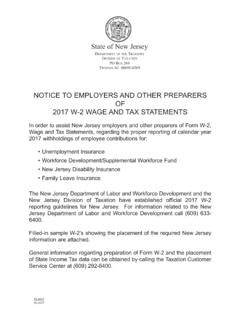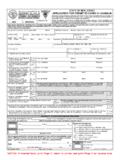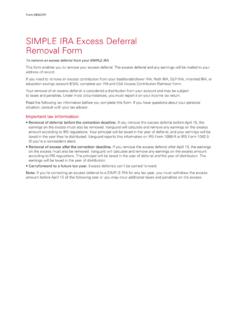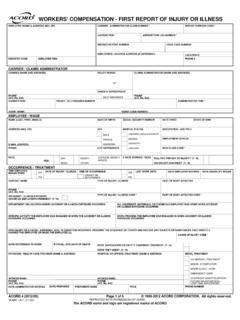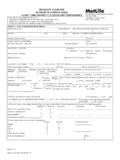Transcription of ALL ABOT 1 - Occupational Safety and Health …
1 1 ALL about OSHAOSHA 3302-11R 2016 This booklet provides a general overview of basic topics related to osha and how it operates. Information provided does not determine compliance responsibilities under osha standards or the Occupational Safety and Health Act of 1970 (OSH Act). Because interpretations and enforcement policy may change over time, you should consult the agency for the most up-to-date information. Much of it is available at the osha website at The website also includes locations and phone numbers for osha offices around the country. If you do not have access to the website, call 1-800-321- osha (6742). This information is available to sensory-impaired individuals upon request. Voice phone: (202) 693-1999; teletypewriter (TTY) number: (877) in this publication is in the public domain and may be reproduced, fully or partially, without permission.
2 Source credit is requested but not photo: Steve Baranowski, Braintree, Massachusetts Area OfficeAll about osha Department of LaborOccupational Safety and Health AdministrationOSHA Department of Labor2 Occupational Safety AND Health ADMINISTRATIONC ontentsOSHA s Mission .. 4 Introduction .. 4 osha Coverage .. 5 Rights and Responsibilities under osha Law .. 9 osha Standards .. 11 Enforcement .. 14 General Reporting and Recordkeeping Requirements .. 17 Filing a Complaint .. 18 osha s Whistleblower Program: Protection from Retaliation .. 19If There is a Dangerous Situation at Work .. 20 Additional Whistleblower Protections .. 21 osha Assistance, Services and Programs .. 27 osha Advisory Committees.
3 31 NIOSH Health Hazard Evaluation Program .. 33 osha Regional Offices .. 34 How to Contact osha .. 373 ALL about OSHAIn 1970, the United States Congress and President Richard Nixon created the Occupational Safety and Health administration ( osha ), a national public Health agency dedicated to the basic proposition that no worker should have to choose between their life and their job. Passed with bipartisan support, the creation of osha was a historic moment of cooperative national reform. The osha law makes it clear that the right to a safe workplace is a basic human right. Since osha s first day on the job, the agency has delivered remarkable progress for our nation. Workplace injuries, illnesses and deaths have fallen dramatically.
4 Together with our state partners, osha has tackled deadly Safety hazards and Health risks. We have established common sense standards and enforced the law against those who put workers at risk. Our standards, enforcement actions, compliance assistance and cooperative programs have saved thousands of lives and prevented countless injuries and illnesses. Looking to the future, osha is committed to protecting workers from toxic chemicals and deadly Safety hazards at work, ensuring that vulnerable workers in high-risk jobs have access to critical information and education about job hazards, and providing employers with vigorous compliance assistance to promote best practices that can save lives. Although our task is far from complete, our progress gives us hope and confidence that osha will continue to make a lasting difference in the lives of our nation s 130 million workers, their families and their communities.
5 4 Occupational Safety AND Health ADMINISTRATIONOSHA s MissionCongress created osha to assure safe and healthful conditions for working men and women by setting and enforcing standards and providing training, outreach, education and compliance the osha law, employers are responsible for providing a safe and healthful workplace for their workers. For more information, visit osha s website at December 29, 1970, President Nixon signed the Occupational Safety and Health Act of 1970 (OSH Act) into law, establishing osha . Coupled with the efforts of employers, workers, Safety and Health professionals, unions and advocates, osha and its state partners have dramatically improved workplace Safety , reducing work-related deaths and injuries by more than 65 1970, an estimated 14,000 workers were killed on the job about 38 every day.
6 For 2010, the Bureau of Labor Statistics reports this number fell to about 4,500 or about 12 workers per day. At the same time, employment has almost doubled to over 130 million workers at more than Photo: James Majors5 ALL about million worksites. The rate of reported serious workplace injuries and illnesses has also dropped markedly, from 11 per 100 workers in 1972 to per 100 workers in 2010. osha s Safety and Health standards, including those for asbestos, fall protection, cotton dust, trenching, machine guarding, benzene, lead and bloodborne pathogens have prevented countless work-related injuries, illnesses and deaths. Nevertheless, far too many preventable injuries and fatalities continue to occur.
7 Significant hazards and unsafe conditions still exist in workplaces; each year more than million working men and women suffer a serious job-related injury or illness. Millions more are exposed to toxic chemicals that may cause illnesses years from now. In addition to the direct impact on individual workers, the negative consequences for America s economy are substantial. Occupational injuries and illnesses cost American employers more than $53 billion a year over $1 billion a week in workers compensation costs alone. Indirect costs to employers, including lost productivity, employee training and replacement costs, and time for investigations following injuries can more than double these costs.
8 Workers and their families suffer great emotional and psychological costs, in addition to the loss of wages and the costs of caring for the injured, which further weakens the economy. osha CoverageThe OSH Act covers most private sector employers and their workers, in addition to some public sector employers and workers in the 50 states and certain territories and jurisdictions under federal authority. Those jurisdictions include the District of Columbia, Puerto Rico, the Virgin Islands, American Samoa, Guam, Northern Mariana Islands, Wake Island, 6 Occupational Safety AND Health ADMINISTRATIONJ ohnston Island, and the Outer Continental Shelf Lands as defined in the Outer Continental Shelf Lands Sector WorkersOSHA covers most private sector employers and workers in all 50 states, the District of Columbia, and other jurisdictions either directly through Federal osha or through an osha -approved state plan.
9 State plans are osha -approved job Safety and Health programs operated by individual states instead of Federal osha . The OSH Act encourages states to develop and operate their own job Safety and Health programs and precludes state enforcement of osha standards unless the state has an approved program. osha approves and monitors all state plans and provides as much as fifty percent of the funding for each program. State-run Safety and Health programs must be at least as effective as the Federal osha program. To find the contact information for the osha Federal or state plan office nearest you, call 1-800-321- osha (6742) or go to following 22 states or territories have osha -approved state programs: Alaska Arizona California Hawaii Indiana Iowa Kentucky Maryland Michigan Minnesota Nevada New Mexico North Carolina Oregon Puerto Rico South Carolina Tennessee Utah Vermont Virginia Washington Wyoming7 ALL about OSHAOSHA-Approved State PlansFederal osha provides coverage to certain workers specifically excluded from a state s plan, for example, those in some states who work in maritime industries or on military interested person or group, including individual workers.
10 With a complaint concerning the operation or administration of a state program may submit a complaint to the appropriate Federal osha regional administrator (regional offices are listed at the end of this guide). This is called a Complaint about State Program administration (CASPA). The complainant s name will be kept confidential. The osha regional administrator will investigate all such complaints, and where complaints are found to be valid, may require appropriate corrective action on the part of the state plans (private sector and public employees)Federal osha (private sector and most federal employees) osha -approved state plans (for public employees only; private sector employees are covered by Federal osha )8 Occupational Safety AND Health ADMINISTRATIONS tate and Local Government WorkersWorkers at state and local government agencies are not covered by Federal osha , but have OSH Act protections if they work in those states that have an osha -approved state program.










